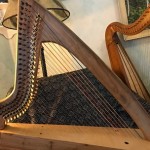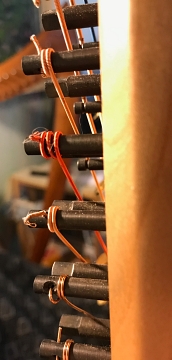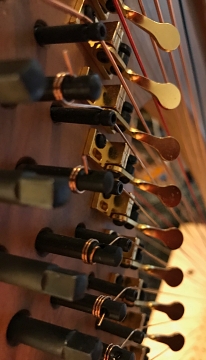 If you’ve been following along, you’ve been reading about my wire harp restringing project over the past two months. It’s gone quite well, with all the bronze monofilaments replaced with copper phosphor bronze wires.
If you’ve been following along, you’ve been reading about my wire harp restringing project over the past two months. It’s gone quite well, with all the bronze monofilaments replaced with copper phosphor bronze wires.
Some of the strings original to the harp broke at the tuning pins as I carefully removed and I noted these in my log. These would most likely have broken in the near future anyway on the next tuning due to metal fatigue.
With all the new strings on, it’s now time to retune my harp.
It has dropped in pitch considerably and at present the six bottom wire-wound strings are tuned at A=415. The next octave up is (temporarily) tuned to A=390, a whole step below A=440. The idea is to give time to let the wires gradually pull the soundboard up – bellying – without breaking themselves.
I have another log where I keep track of the tuning on a daily basis. The wires have a sort of elasticity that develops after a while and you can take them up a note or two without worry of breaking them. If they seem very tight and the tuning pin doesn’t turn easily, don’t force them. You can test the elasticity by bouncing your finger against the wires. The ones that have a certain degree of slack are ready to come up a few degrees in pitch. This may take a few days.

Bass CPB wire strings. Also note that these do not cross themselves on the pins, which could damage the outer wire wrapping.
I’ve been researching the topic of concert pitch. A440 is a comparatively recent standard (1940’s onward). During the early part of the 20th century, A435 was used. During previous centuries, A415 was more common, which is a half step lower than used today.
And during the Middle Ages and Renaissance, the era of the Irish wire harp, there was no concert pitch as we understand it today. Instruments were tuned to themselves first and then tuned to the other instruments they might be playing with. Tuning forks were invented in 1711 and today we use our smartphone apps! But in the medieval era, tuning was more about pitch relationships: intervals and octaves and how they sounded relative to one another, than it was about relating to an external international standard measured in Hz. that everyone had to calibrate to.
Symphony orchestras are famous for going above A440. Conductors have insisted, even demanded their musicians tune their instruments to A442, A444, A445. See Boston Symphony Orchestra, et al. I won’t even go into the history of this here, but it has to be brutal on the string section…
So I’ve discovered that A440 is pretty rough on wire harps. The tension is very high. (I would even say damaging.) My other two older harps are at A415, a Baroque pitch. If I want to play with the church’s pipe organ tuned to today’s accepted concert pitch, I just transpose. Or George does. (We take turns transposing on Sunday mornings.)
Anyway, I am seriously considerably leaving this harp at A415 as well, for a long and healthy life.
Or… A390 is actually a whole step, or one note below A440 and very Baroque! I could leave the harp there…
My thinking these days is that although all three of my wire harps are modern instruments built in the 21st century and even capable of playing chromatics (!), which is something their predecessors in the Middle Ages couldn’t do, their structural roots: i.e., their overall shape and design, is still medieval. Low pitch tuning seems to reduce frequent string breakage (I haven’t broken a string on my Triplett Luna in years and never once on my Stoney End Esabelle). Although string makers and harp builders can temporarily make them go that high, the harps don’t seem to be able to sustain it in the long run. In my experience.

